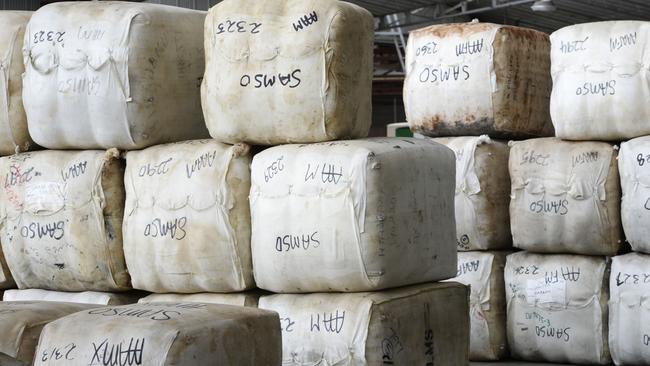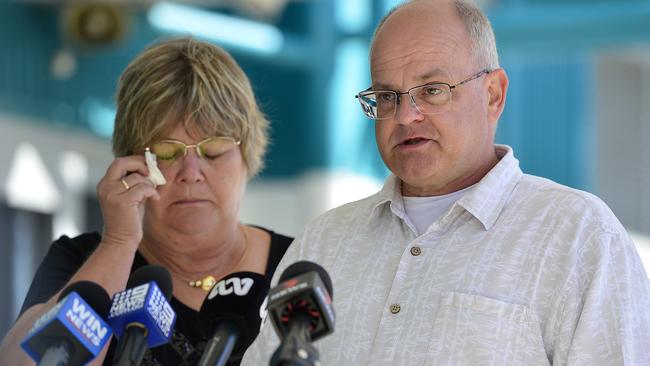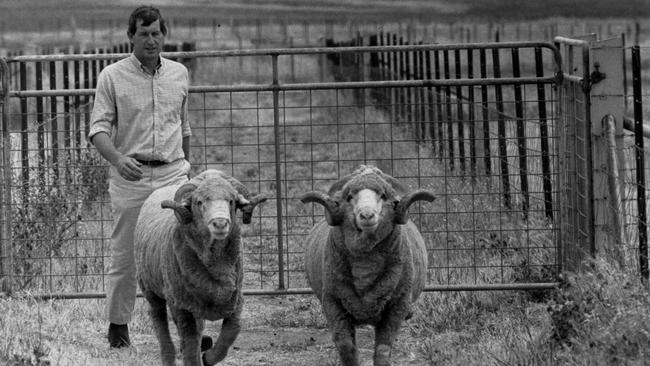Corey Ireland, Chris Delforce, live export ban: Biggest livestock scandals revealed
Here are some of the biggest scandals to rock the livestock industry. Almost 50 per cent of readers say one event changed the sector the most.

From farm invasions to a whole industry on its knees and a man hiding behind a mirror.
They are just some of the scandals that have rocked the livestock sector in the past few decades.
The Weekly Times is looking back at some of the biggest and most memorable controversies that have raised eyebrows in the livestock industry.
Some of them have changed the industry for the better, some have had long-lasting effects on people and businesses and there are some that people would simply rather forget.
We asked readers to vote for which event changed the industry the most.
Unsurprisingly, the event that came in with 49 per cent of votes was the 2011 ban on live exports, followed by 39 per cent for the wool reserve price scheme collapse.
You can still have your say in our poll below, or tell us if we have missed something that should be included.
THE MAN IN THE MIRROR

It has been four years since one of the most ludicrous events in the Australian wool industry.
Former Australian Wool Innovation chairman and Boorowa wool grower Wal Merriman came under fire in 2017 for the “man-in-the-mirror” scandal and his subsequent behaviour towards an ABC journalist.
Mr Merriman secretly watched a focus group of stud breeders, who use the genetic appraisal MerinoSelect, through a one-way mirror. Participants were assured anonymity and did not know Mr Merriman would be observing.
The incident was labelled “unethical” by wool growers and prompted calls for Mr Merriman to resign.
When the man-in-the-mirror story came to light, Mr Merriman hit the headlines again when he called an ABC journalist asking questions about the matter a “useless prick” and told him to “f--- off — report that”.
While Mr Merriman fronted a Rural and Regional Affairs and Transport Legislation Committee hearing and apologised several weeks after the incident was revealed, the initial reaction from AWI was to lay blame for the incident squarely at the foot of the ABC journalist.
Despite the fallout from both incidents, Mr Merriman continued in his role as chair until he resigned in early November 2018, more than 12 months later.
He had been on the AWI board since 2004 and in the role of chairman since 2008.
He then remained as a director of AWI until levy payers voted him out an annual general meeting in November 2019.
THE 2011 LIVE EXPORT BAN

The controversial ban on live exports was a turning point for the livestock industry, according to insiders.
Last year marked the 10-year anniversary of the June 2011 six-month blanket ban, which was placed on Australia’s live cattle exports to Indonesia.
It stemmed from an ABC Four Corners report on cruelty in Indonesian abattoirs.
While all — both within and outside the industry — agreed the cruelty should never have happened, the snap ban was widely criticised.
So much so, a landmark class action against the Commonwealth Government ruled in June 2020 that the ban was unlawful.
The ban, which decimated the industry and took a huge emotional and financial toll on northern cattle producers, led to the establishment of the Export Supply Chain Assurance Scheme, designed to improve standards in live exports.
Reflecting on the 10 years since, Australian Livestock Exporters Council chief executive Mark Harvey-Sutton told The Weekly Times there were major lessons from the ban that the industry needed to remember.
“One is that what happened was completely unacceptable and it was the turning point for the industry in taking responsibility for animal welfare in-market,” Mr Harvey-Sutton said.
He said it “strengthened” the industry.
“We are the only country that takes responsibility for livestock in other markets, and it is something the industry has embraced and striven for since then.”
WOOL RESERVE PRICE SCHEME COLLAPSE

Wool prices have travelled in boom and bust cycles since the start of the last century.
But no event in Australia’s wool history has had quite the same impact as the reserve price scheme collapse of 1991.
It was one of the catalysts for the national sheep flock dropping from 180 million sheep in the late 1980s to about 70 million sheep now.
The wool reserve price scheme was introduced in 1974 to provide a guaranteed minimum price for wool. The scheme was funded by tax and all wool not meeting the minimum price was purchased by the Australian Wool Corporation, with the wool sold during higher price peaks.
The reserve price rose to 870c/kg in the late 1980s, and as production increased, the national wool stockpile grew to 4.7 million bales.
In February 1991, the reserve price scheme was suspended and the market collapsed.
Independent Commodity Services analyst Andrew Woods said prices dropped 70 per cent, almost overnight.
It then took 10 years for the stockpile to be sold and according to many in the industry, wool has never recovered.
More than 30 years on, Mr Woods said in some respects the industry learnt from its mistakes, but in others it hadn’t.
“The failure of the reserve price scheme was the death knell for market support schemes, which is useful, but there are other areas that haven’t changed,” he said.
“There’s a lack of funds flowing into on-farm research in red meat and wool, the industry still isn’t investing in enough research for the future.”
There’s been much written and speculated about the whys and what-ifs of the collapse of the reserve price, but one book, Charles Massey’s Breaking the Sheep’s Back, comprehensively covers the disaster.
In it, he says the event cost the wool industry more than 40 times the money lost in the Australian Wheat Board scandal.
While Mr Massey’s book was published 10 years ago, some of his introductory comments are critical of the current governance of the industry.
“(The) industry stumbles on, trapped in a non-commercial, non-customer focused culture — and still under inept statutory governance.”
“The prevailing governance continues to shackle the industry.”
IRELANDS ANGUS

Corey and Prue Ireland had the beef cattle world at their feet.
But the unravelling all started with misrepresenting a bull in a catalogue — and then it all fell from there.
Back in March 2019 the NSW District Court ruled Wagga Wagga stud Irelands Angus sold a bull, Irelands Kelleher K34, for $18,000 to Bongongo Angus in August 2015, only for it to be discovered the bull’s sire was not the one noted in the sale catalogue.
Irelands Angus, owned and operated by Corey and Prue Ireland, was ordered to pay $200,191.88 to Bongongo for the error.
This prompted Angus Australia to more strongly promote their recommendations on parent verification for sale animals.
To sum up the lengthy and ongoing saga, in December 2011, the Irelands set up CD & PJ Ireland Pty Limited as the trustee for the Ireland family trust.
The full extent of the Irelands’ Angus empire began to unravel when East Coast Stockfeeds won permission in the courts in 2019 to wind up CD & PJ Ireland Pty Limited and appoint liquidators.
Then a string of creditors took CD & PJ Ireland Pty Limited and associated company Irelands Angus Breeding, plus Mr and Mrs Ireland, to various courts to recover what they were owed.
Debts of at least $10.5 million show up in the liquidators’ initial report.
Mr Ireland is facing 13 counts of fraud in the Wagga Wagga Local Court on allegations of dishonestly obtaining financial advantage by deception.
Further to this, criminal cases against Mr and Mrs Ireland in the Sutherland Local Court brought by the Australian Securities and Investments Commission for allegedly failing to hand over books to a liquidator was adjourned until June 28 this year.
The scandal is ongoing and the truth won’t fully come to light until some of the cases have been heard in court and judges have made rulings.
GULF LIVESTOCK 1 SINKING

It has been more than 12 months since an Australian-commissioned livestock ship sunk off the coast of Japan.
The families of those missing are still searching for answers, with no authorities wanting to take responsibility for the tragedy.
In September 2020 the Panama-registered Gulf Livestock 1, owned by UAE-based company Gulf Navigation Holdings and on a contract voyage for the Melbourne-based Australasian Global Exports with 5800 dairy heifers and 43 crew on board, was lost at sea near Japan’s Amami Oshima Island.
The ship was on its way from Napier in New Zealand to China when it went missing in an area affected by Typhoon Maysak.
A Filipino crewmen was the only survivor. He reportedly told authorities the ship stalled and capsized after being hit by a powerful wave. The ship has not been located.
Among those missing are Australians William Mainprize, who was a stockperson on the vessel, and Queensland veterinarian Lukas Orda. Two New Zealanders were also on board.
Lukas Orda’s parents, Ulrich and Sabine Orda from Mt Isa in Queensland, told The Weekly Times on the 12-month anniversary the search was never “done appropriately” and there had been “no interest from Australia to push for a report” into the tragedy.
AUSSIE FARMS MAP AND THE GIPPY GOAT THEFT

Animal activist group Aussie Farms — now known as the Farm Transparency Project — outraged farmers, politicians and the general public in early 2019 when it launched an interactive satellite map detailing thousands of farmers.
The group, driven by Chris Delforce, wants to see animal agriculture abolished and just two weeks after launching had removed questions from its membership form that could imply it supported its members breaking the law (for example breaking into properties).
The map was labelled an “attack map” by then Agriculture Minister David Littleproud and the Government called for it to be shut down.
The year of its launch was plagued by farm invasions and ramifications for many farmers and businesses.
Some animal rights activists were using public donations to break into farms and steal livestock.
And at least two farmers on the map closed their businesses in 2019 after invasions.
John Gommans closed his Gippy Goat Cafe at Yarragon after 70 activists stormed his property and stole three goats and a lamb.
A poultry farmer sold his Victorian property after being left “psychologically damaged” from activist attacks, including one that he said resulted in 300 chickens smothering to death.
The Federal Government brought Aussie Farms under the Privacy Act, from which it used to be exempt, in April 2019, allowing the Office of the Australian Information Commissioner to make “inquiries” into Aussie Farms’ “collection of personal information” and “notification practices”.
An official investigation led by Commissioner Angelene Falk was launched in November 2019.
In October last year the investigation was nearing finalisation.
Farmers are still waiting to hear if the OAIC will take action and shut the map down.
STATE BANK OF SOUTH AUSTRALIA DOWNFALL

The legendary Collinsville Merino stud, from South Australia, which was first registered as a flock in 1895, is best known for its big, quality sheep.
But it was mired in controversy in the early 1990s when it played a part in the downfall of the State Bank of South Australia.
At the time, wool was booming and Collinsville was at the top of its game, having sold a Merino ram in 1988 for a world-record price of $450,000 at the Adelaide Show.
A few years after that sale the wool price collapsed and Collinsville went into receivership.
Collinsville was in debt about $45 million, owed mostly to the State Bank of South Australia.
This debt was a significant factor in the collapse of the bank.
It was reported the then owner of Collinsville, Neil Garnett, met bank boss Tim Marcus Clark at the 1989 Burra show, and that meeting sparked a huge multimillion-dollar loan.
Within two years the State Bank of South Australia had lost about $30 million.
The South Australian Auditor-General’s investigation into the State Bank of South Australia collapse dedicated a whole chapter to the Collinsville loan.
After the stud went into receivership, BRW rich listers Paddy and Helen Handbury paid $7 million for it in 1995, and in 2014 Collinsville changed hands again, with George and Sophie Millington purchasing it.
Collinsville has remained out of controversy since, with a square focus on operating one of the biggest sheep studs in the country and breeding some of the most profitable sheep.




